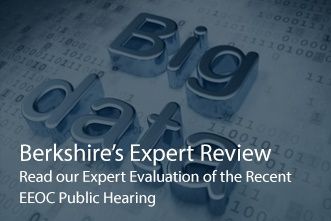The Equal Employment Opportunity Commission (EEOC) recently updated its Strategic Enforcement Plan for FY 2017- 2021 to include a focus on “the increasing use of data-driven screening tools” in hiring and other employment contexts. The agency also held a recent public hearing on the topic, with a panel of attorneys, labor economists, and industrial psychologists telling the agency the use and scope of big data in the employment context is “expected to grow exponentially in the future.”
2021 to include a focus on “the increasing use of data-driven screening tools” in hiring and other employment contexts. The agency also held a recent public hearing on the topic, with a panel of attorneys, labor economists, and industrial psychologists telling the agency the use and scope of big data in the employment context is “expected to grow exponentially in the future.”
What is big data you ask? Generally speaking, big data refers to extremely large sets of information that can be gathered from different sources to reveal trends, patterns, habits, etc. to predict behavior. Digital footprints (trails created from unique activities, actions when using the internet) are constantly being created to tell a story about the user. The size of your footprint increases while surfing the internet, participating in social media, making online purchases, and such.
Big data is most often being used in marketing, but panelists told the EEOC its use has bled into the HR sphere. Employers are already using algorithms, “data scraping” of the internet, and other evaluation tools to make employment decisions. Predictive analytic tools are most often being used to assist organizations in finding the best person for the job. Companies who provide these services offer employers automated processes that seek to identify candidates who have traits that correlate to strong job performance through the use of big data.
At the EEOC meeting, proponents for using data analytics argued that its use helps to eliminate discrimination and human biases such as “like me” hiring. These experts noted big data techniques could assist recruiters in making more informed decisions about which candidates are most qualified based on job-related reasons. “It’s an exciting era because this capability is going to give a fair shot to millions of job applicants who wouldn’t have been considered previously,” said Dr. Michael Housman, a workforce scientist with a background in Applied Economics.
The thought of being able to press a button and get applicants from a huge pool that fit your profile and skill set is an intriguing one, but, according to other panelists, there are several things you should consider. For example, panelists noted there might be flawed assumptions built into the algorithms, which can negatively impact protected groups. As a result, panelists cautioned that employers need to understand the factors that are being used to build the algorithms and have the ability to comprehend the results.
So why is the EEOC discussing this topic? To determine what the agency can do to enhance the positive and minimize the negative. For example, people with disabilities, women with children, the poor, andVeterans, may have a larger number of absences. People who are not on social media, spend little time surfing the internet, or have limited access to the internet may have smaller digital footprints. Are algorithms being created that might, intentionally or unintentionally, exclude these groups? Are candidates and employees aware of the information being gathered and how it is being used? Are there privacy concerns?
As the EEOC continues to explore and educate employers about the use of big data, employers should take the time now to learn how big data can be used to improve employment decisions without negatively impacting protected groups. For now, expect the EEOC, and Office of Federal Contract Compliance Programs (OFFCP) who also attended the meeting, to begin asking questions about whether your organization is using big data to make employment decisions and how.
-1.png)

.png?width=593&name=MicrosoftTeams-image%20(4).png)